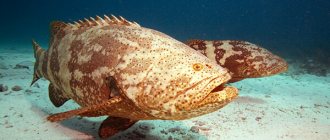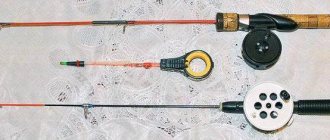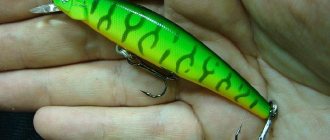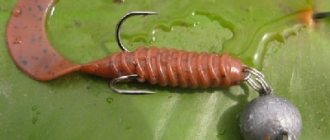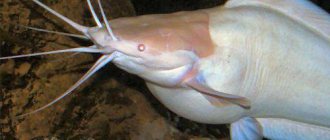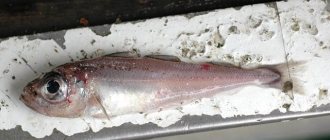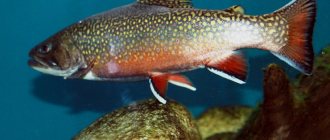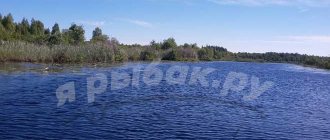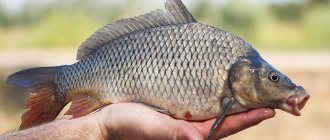Either it's a fish or it's not
Thanks to their long (sometimes up to 1 meter), snake-like and mucus-covered body, lampreys closely resemble eels. Due to their unique physiology, zoologists do not classify them as classical fish, classifying these primitive vertebrates as a special class of cyclostomes.
A special feature of this strange-looking fish is the absence of paired fins and bones. The skeleton consists of cartilage, and the spine is replaced by a flexible rod. Its gills are also unusual; there are 7 gill openings on the sides, for which the river lamprey received another name among the people - seven-hole. Three eyes on her head also do not add to her attractiveness. The rounded mouth is the same as that of a leech. It plays the role of a suction cup, with the help of which the fish can stick to stones or snags. The river lamprey is a predator. About a hundred teeth located along the edges of the mouth allow it to make a hole in the victim’s skin and eat into it using its tongue, which also has a row of teeth.
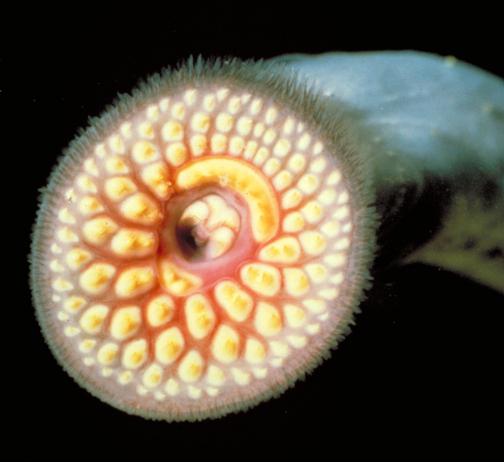
The lamprey can parasitize the body of its prey for a very long time because it does not use its mouth for breathing. The absence of an air bubble does not allow this fish to swim, so it spends almost all its time at the bottom, camouflaged in the thickness of the silt.
What do lampreys eat?
For carnivorous species, the main source of food is the blood of a variety of freshwater and marine fish. Some lamprey victims:
- herring;
- trout;
- mackerel;
- salmon;
- sharks;
- marine mammals.
Lampreys bite into prey using a sucker-like mouth and scrape off the skin with their teeth. Small fish species die after such a traumatic bite and constant loss of blood.
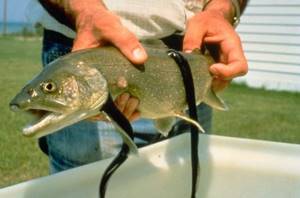
Habitats
The lamprey is mainly found in freshwater rivers and coastal sea waters. The movements of these animals into the open sea are not so rare. It is found in the river basins of the North Sea, along the coasts of Italy, France, Norway, and England. In Russia, it often enters the rivers of the Gulf of Finland and the Kaliningrad region to spawn. The river lamprey is especially common on the Baltic coast, where it lives almost everywhere. Less common in rivers of Belarus; single specimens are present in the Neman and Western Dvina.
How does it reproduce?
The Hungarian lamprey fish breeds in April-June exclusively in fresh water heated to 8 C. Fertility is high, up to ten thousand eggs. For the sake of spawning, they have to swim upstream of the river.
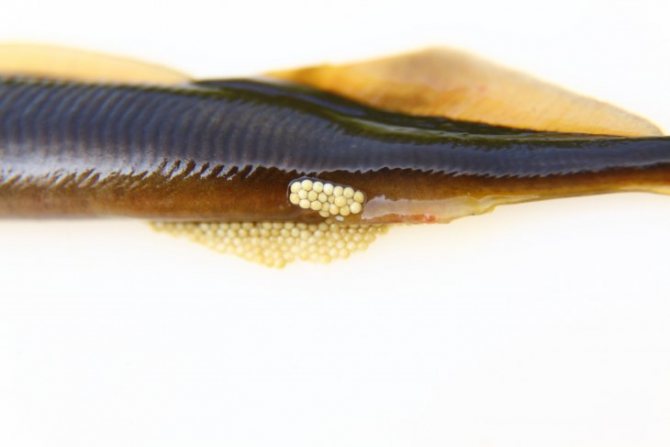
In fact, no one has ever observed the spawning process. The male always chooses the place to lay eggs. With its nimble body, it creates a small depression at the bottom of the river, and removes small debris using suction cups.
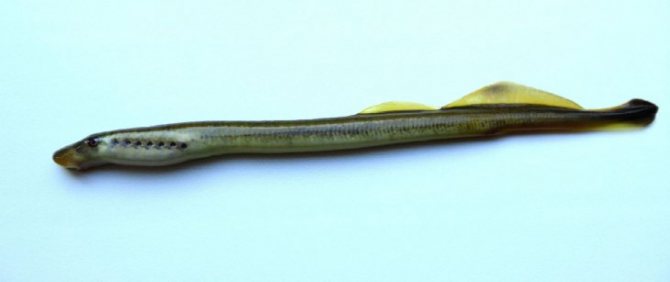
Fights often occur between males for the right to take the best place for offspring. After the appearance of the larvae, the female does not live long, one to two years.
Lamprey lifestyle
Despite the fact that this fish is a predator, it moves very sluggishly. This slowness is explained by the fact that the lamprey’s diet consists of dead animals and fish, as well as organic substances, which are found mainly in silt. Therefore, there is no need to chase the prey to catch it. The lamprey manages to move long distances by clinging to some fish. Then her victim serves not only as a source of food, but also as a means of transportation.
On the other hand, such a sedentary lifestyle makes the lamprey an easy prey for other predators that live in the water, especially such as burbot, catfish, and eel, which live at the bottom of the river.
Lamprey (fish) sometimes poses a danger to fishermen.

The photo, which shows river fishing at the moment of catching a lamprey, clearly shows how it is necessary to hold this predator so that it does not sink its teeth into your hand.
Appearance and body structure
This fish looks like an eel: it has an elongated cylindrical body, on which there are no paired fins. The anal fin in females appears before spawning, and the size of the dorsal fin increases during the breeding season.
The color depends on the habitat. River and sea inhabitants are colored differently. Freshwater inhabitants have matte gray or dark blue skin; scales are missing. In the sea there are individuals with a bronze tint. The back is dark, the sides are silver. The abdomen is light, dirty white. The skin is mucous.
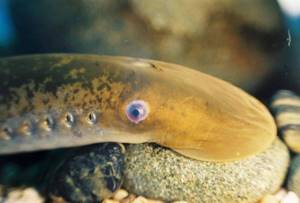
The oral apparatus is funnel-shaped, supported by annular cartilage, surrounded by a sucker. The teeth are horny, designed for scraping soft tissue from the bones of the victim. On the maxillary plate there is 1 tooth at the edges. The bottom plate most often contains 7 teeth. On the upper lip there are randomly located from 4 to 13 teeth. Nostril - 1. Eyes - 3, one of them does not have a lens.
The circulatory system is closed, the heart is two-chambered. The eyes are covered with a layer of skin and are poorly developed. There are 7 gill sacs. They work independently of each other. There is no air bubble.
Body length can vary from 10 to 100 cm.
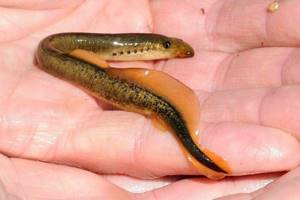
Spawning
Lampreys become sexually mature when they reach a length of 20-25 cm. They rise into the rivers in the spring - from the end of May to mid-June, when the water warms up to 12-13 degrees. Migrations are carried out mainly at night, because due to the negative reaction to light, the lamprey’s movement depends on the phase of the moon - on a dark night it is more intense. During the ripening period of eggs, the fish's body undergoes some changes. The teeth become blunter, the dorsal fins enlarge, and the intestines degenerate.
The male builds the nest. With its body, it clears a small area at the bottom of the river (up to 50 cm wide), even removing stones from it. By sucking on them and immediately jumping away sharply, he manages to take them out of the nest. He can also push out an uninvited guest in the form of another male.
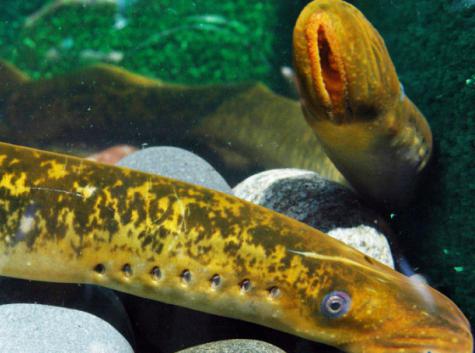
By the time construction is completed, a female appears at the nest. Having attached itself to a stone, it lays eggs. At this time, the male wraps his body around her and helps squeeze out the eggs, pouring milk on them. At the end of spawning, both producers huddle in a dark place and die.
The river lamprey has a fecundity of 16,000 to 40,000 eggs, pear-shaped and about 1 mm in size.
Fish "River lamprey" photo and description
Latin name:
Lampetra fluviatilis
Other names:
Baltic lamprey

Family:
Lampreys
Type:
semi-anadromous
Lifestyle:
benthic
Feeding type:
peaceful
Habitat:
Baltic Sea basin, Arctic Ocean basin
Description:
A parasitic lamprey, it has anadromous and residential populations. It differs from the closely related species L. Planeri primarily in its larger body size and sharp teeth (blunt during spawning), smaller eggs, and the fact that the intestines are functional in adult fish. There is 1 tooth along the edges of the maxillary plate, and usually 7 teeth on the mandibular plate. The upper labial teeth, numbering from 4 to 13, are scattered in disorder. There are 3 internal labial teeth, of which the upper and lower are bipartite, the middle one is tripartite. There are no external lateral teeth. By the time of spawning, the dorsal fins become higher and touch, an anal fin appears in females, and a urogenital papilla appears in males.
There are no subspecies. Large and small forms are known, as well as seasonal races from the Neva basin. Residential forms of lamprey from the rivers of the Gulf of Finland, as well as from Lakes Ladoga and Onega, which occur sympatrically with L. fluviatilis, were described as independent forms of L. fluviatilis forma praecox (Berg, 1948) and L. fluviatilis forma ladogensis. Its relationship with L. planeri is not entirely clear, with which it is very similar in protein composition and the amount of nuclear DNA (41.3% of human, or 2.5 pg). Previously, L. fluviatilis and L. planer were considered to be separate races of the same species.
Appearance:
Walking lampreys have a metallic bronze color; in the river they turn matte and dark blue. Individuals migrating for spawning have a maximum length of 48 cm and a weight of 150 g, the residential forms of large lakes are 33 cm and the small form is 25 cm
Habitat and behavioral characteristics:
River basins of the North and Baltic Seas from France and England to Sweden, Finland and Karelia. There are isolated populations outside the main range in Italy. In Russia, it spawns in the rivers of the Kaliningrad region and the Gulf of Finland (Neva, Narva, Luga), and is known from the basins of Lakes Ladoga and Onega. Perhaps in Lakes Ladoga and Onega there is a residential form of lamprey that lives at depths of 50-100 m.
Nutrition Features:
Parasitic lamprey with anadromous and residential forms. River lamprey prefers large rivers. Sandworts live both on the main channel and near the banks in silted areas, but sometimes also among thickets of macrophytes; they lead a hidden lifestyle and burrow into the ground. They feed on detritus, diatoms and other small algae, but may also consume small worms and crustaceans, which is unusual for lampreys. Adult river lamprey feeds in river estuaries or near the sea coast, accompanying schools of herring, sprat, cod; its victims can be salmon, mackerel, and smelt. Moreover, in terms of the type of nutrition, it is not only a parasite that feeds on the blood of fish, but also a parasite with the makings of a predator, since fragments of muscles, bones, scales, intestines, gonads and the heart of prey species (herring, sprat, smelt) were found in the digestive tract of the lamprey ( Hardisty, 1986). In the river, the migratory lamprey does not feed, and its intestines degenerate. Residential forms in lakes attach themselves to vendace, whitefish, brown trout, and roach. Individuals migrating for spawning reach a maximum length of 18-42 cm and a weight of 30-150 g.
Reproduction:
The small form becomes sexually mature at a length of 18-25 cm, as an exception at 12.5 cm and the sandworm stage lasts only 2-3 years (Berg, 1948; Hardisty, 1986). The rise of river lamprey into rivers occurs in spring and autumn, some individuals migrate even in winter. Migration of lampreys in the river occurs at night; they have a clearly expressed negative reaction to light, so the intensity of the stroke depends on the phase of the moon. Noticeable both external and internal changes occur in the river: eggs and milt ripen, the intestines degenerate and turn into a thin strand, the teeth become blunt, the dorsal fins enlarge and the gap between them decreases. In females the dorsal fin enlarges, in males a genital papilla appears. Not only the mass of lampreys decreases, but also their length. Spawning occurs in May-June, most often at a water temperature of 10-14C, on rocky rifts. The male builds a nest, the female lays eggs. Spawning is often group spawning; up to 6 males spawn with one female; usually more than 2 individuals lay eggs in one nest. The Neva lamprey has a fecundity of 4,000 to 40,000, the resident Ladoga lamprey – 10,000-16,000, and the small form – 650-10,000 eggs. The eggs are oval in shape, about 1 mm in size, their volume increases before spawning and after fertilization. Soon after spawning, the spawners die. The incubation period for eggs lasts 13-15 days at a temperature of 13-14C and 11-13 days at 15.5-17.5C. When emerging from the eggs, the larvae are 4 mm long; they remain in the nest for 4-5 days, after which they roll downstream, burrow into the mud and begin to actively feed on detritus and diatoms. The larval stage lasts 4-5 years. It was often observed that L. planeri also spawned in nests of L. fluviatilis.
LAMPREY-LAMPRENE - In some areas, lampreys are also called loach, eel (in the Upper Volga); larvae - sandworms, bindweeds, blind bindweeds; on the Neva - live bait, on the Dnieper - spindles, in Voronezh - squeak. In Finnish - nakiainen, silmu; among the Izhors - silmud; among Latvians - neges, suttini; among the Estonians - silmud, aggexasilmad. In Poland - lamprey, ssach, lamprey; lit. - Nege, Devinakis.
Among the most interesting fish in Russia, both in terms of some very important features in organization, reproduction and way of life, and partly in terms of its industrial significance, is undoubtedly the lamprey, which (of course, only in pickled form) is, without a doubt, well known and to our readers. In its form and general appearance, the lamprey has very little in common with our ordinary fish species. Its long, cylindrical, snake-like body, although somewhat reminiscent of a loach, and even more of an eel, which is why these names are sometimes given to it, has very important and sharp differences: the entire skin of the lamprey is completely devoid of those small scales that, upon careful examination, turn out to be on these the last fish: the lamprey has neither pectoral nor ventral paired fins and has only one nasal opening, lying in the middle of the head, slightly in front of the eyes; her mouth is ring-shaped and quite similar to the mouth of a leech.
The most important, as well as the most striking, differences of the lamprey lie in the special structure of its gills. At the first glance at this wonderful fish, on each side of the front, thicker end of its wavy body, seven small holes are noticed, which served as the basis for its apt name on the Kama - seven-hole, the only Russian one, since the real name is “lamprey”, obviously comes from the German Neunauge - nine eyes, in which, as you can see, the Germans showed a little observation.
These fourteen holes, located in two shallow grooves, or grooves, lead into small leathery sacs, which are the gills. Thus, the latter are structured completely differently than those of other fish. The very process of lamprey breathing is also different. In all other fish, water, which contains air and serves for respiration, passes through the mouth; in lampreys, with each expansion, it enters, and with each compression of the sacs, which is produced by special muscles, it comes out of the hole. We will see later that this kind of breathing is in direct connection and dependence with the way of eating.
Finally, there is a very important difference between this fish and the vast majority of others. Anyone who has eaten lamprey remembers very well that it has no bones or ribs at all, like our ordinary fish, and that it is eaten whole, with even less effort than sturgeon, whose skeleton consists of cartilage.
This occurs because the vertebral column of the lamprey is almost completely replaced by the so-called. elmfish, also found in sturgeons, but in relatively less development, and almost only one head consists of cartilage. To Europe In Russia, there are actually two or three species of lampreys. One of them lives in rivers and streams, the other - in rivers, and therefore the first is called the brook lamprey, the second - the river lamprey. The main and obvious difference between them is in growth: the stream (Petromyzon planeri), much smaller than the stream and very rarely reaches one foot in length; in most cases it is half as much, while the river one sometimes reaches a foot and a half in length and the thickness of two fingers. Another, also visual, distinctive feature is that in the river lamprey the dorsal fin is separated by a rather significant gap from the caudal one, while in the river lamprey both fins appear almost fused. The third species (Petromyzon Wagneri Kessl.), or Caspian lamprey, found in the Caspian basin, is very similar to the river lamprey (Petromyzon fluviatilis), which belongs to the basin of the Baltic and Arctic seas itself and has only a slightly different mouth structure. It is not known to what species the lamprey of the Dnieper and Don basin belongs, reaching Smolensk (Korde) and Voronezh (Venevitinov), where, however, only its larvae were found; in the seas, and here in the Baltic, there is an even larger lamprey, but in rivers, at least in Russia, it is never found and has never even been found in the Gulf of Finland.
Both river lampreys are found both in the sea and in large lakes, such as Ladoga, Onega, Pskov and in places, especially in the basins of the first three seas, in such a myriad of numbers that they are often scooped out of ice holes with nets, scoops and buckets, although until now, as we will see later, it is a subject of fishing only in a few places. The brook lamprey, on the contrary, was seen only in a few rivers of Russia, which, of course, depends both on the fact that it was probably sometimes mixed with the river lamprey, and on its location. Until now, it has only been observed in Finland (up to 64° N). Baltic provinces and in a few rivers flowing into the Dnieper, and from the middle and Volga provinces only I managed to find it in one of the rivers of the Yaroslavl district. From this it is easy, however, to conclude that it is widespread in most of European Russia, with the possible exception of our northern rivers. In general, this latter does not have any industrial significance for us, but it is important because very important and interesting observations were made on it in Western Europe regarding its reproduction and way of life, to which we are moving on.
Despite, however, these important observations, the abundance and prevalence of lampreys, their life still presents many gaps, which is due to the very secretive lifestyle of these fish. According to their worm-like physique, the absence of a swim bladder and paired fins, lampreys always stay at the bottom, so to speak, reptiles on the bottom of rivers and lakes. This circumstance, combined with their nocturnal life, makes it even more difficult to observe them. During the day, seeing a lamprey motionlessly clinging to underwater rocks, stones and snags, and even more so burrowing into the mud, is very tricky; Moreover, in ordinary times of the year it is never found in large and dense flocks, but is mostly seen alone. Only before spawning, when the most important, most prey fishing for it begins, is it noticed in huge numbers, in whole masses.
At the bottom, the lamprey looks for its food, which consists partly of organic substances contained in silt, but, apparently, exclusively from the meat of both dead fish and other drowned animals, and living fish. Some fishermen of Lake Ladoga claim that at other times it is almost completely impossible to fish for whitefish with hooks, because the caught whitefish are literally completely eaten by lampreys overnight. Such exclusive feeding on fish meat or carrion is proven, firstly, by the fact that there are no remains of insects in the stomach of lampreys and they never eat a worm; secondly, by the very structure of the mouth, which allows food to be taken exclusively through suction to the object that serves them as food. With their numerous teeth, sitting on a ring-shaped lip and special cartilaginous plates, as if corresponding to the jaws, lampreys drill into the skin of fish and then eat deeply into them with the help of a tongue, which is also lined with teeth on the front edge and at the same time acts like a piston. This method of feeding, which is not found in other fish, is obviously possible only with the structure of the gills described above: otherwise, the feeding and generally sucking lamprey would have no way of taking water into the mouth, and therefore breathing. Further we will see, however, that brook lampreys, perhaps, do not consume any food at all. Nevertheless, what we have said applies to river lampreys, on which all the above-mentioned observations were made.
In turn, due to their immobility and relatively slow movements (which again serves as proof that they feed mainly on carrion or already caught fish), lampreys often become food for other, larger and more predatory fish, especially those that, like them, stick to the bottom more. Such main enemies of lampreys include catfish, burbot and especially eel, which, however, are an exclusive inhabitant of rivers flowing into the Baltic Sea. The voluminous stomach of a medium-sized eel can easily accommodate more than a dozen lampreys, and since it usually swallows them whole and, being caught and squeezed with its hands, vomits them back, this was a frequent reason for fishermen to tell stories about the liveliness of the eel. This misconception, in all likelihood, was facilitated by the fact that river lampreys are distinguished by their extraordinary vitality and not only remain alive for many hours, being sealed in a tightly closed jar, completely without water, but continue to move long after their belly was opened. Hence, it may very well be that the freshly swallowed lampreys did not yet have time to undergo the decomposing action of gastric juice and were squeezed out of the eel’s mouth while still alive.
Observations of spawning are more complete and reliable regarding brook lampreys. We probably know about them that they spawn in Western Europe in April; with us, probably later - precisely in May, which can be concluded from the fact that in 1866, on May 5, I found one brook lamprey with eggs that had not yet been spawned, and on the 29th of the following year they apparently began to spawn , as they gathered together and stuck tens of them to one stone. Both times I met them on shallow and rocky riffles of the river, from which it should be concluded that brook lampreys spawn in these places, with which Baldner’s long-standing observations also agree. August Müller, who gave the most detailed description of the spawning of these fish and the development of their eggs and young fish, saw how the male eggs were sucked to the back of the eggs and bent in such a way that the belly of the male was pressed against the belly of the female; then the latter began to release her testicles, and the male at the same time released his milk. The female, however, never lays all her eggs at once, but releases them in several stages. These testicles are pale yellow in color, have a diameter of almost half a line and are relatively larger and fewer in number than those of most of our fish and even the river lamprey, although they should still be counted in the thousands. At the end of the same day, the formation of an embryo begins in the egg and after two and a half weeks the shell of the egg bursts and a young fish emerges from it.
The latter, however, differs sharply both from its parents and from all other fish in general. First of all, attention is drawn to the complete absence of the yolk sac, which is initially noticed in all young fish and in the first days of life, when they are still too weak to find food for themselves, supports their existence. This circumstance is easily explained by the fact that in the lamprey testicle the entire yolk, like in frogs, goes towards the formation of the embryo. Then the young lamprey’s eyes, which are always disproportionately large in other fish, appear in the form of two inconspicuous black dots, and finally, the very structure of its head turns out to be very different from that of old lampreys. Thus, the young lamprey bears a vague resemblance to the old one, and we see here a remarkable and only example of the existence of a larva in fish. With further development, there is no longer any doubt that this larva is the same fish that for a long time, until the end of the fifties, when the mentioned studies of August Müller were published, was considered under the name of sand miner a completely separate species, even classified as a different genus. This will be very understandable if we say that the very small head of the sand miner is completely devoid of teeth, so numerous in the adult lamprey, and is equipped not with one ring-shaped lip, but with two - upper and lower, of which the first is incomparably wider and completely covers the latter from the sides, that their eyes, initially appearing in the form of two black dots, soon become completely inconspicuous. This, of course, is where their name comes from - blind bindweeds, which is used by most Russian fishermen, who consider them a completely different fish, not even a fish, but a worm. These blind larvae of brook lampreys - sandworms - lead a completely different lifestyle. They constantly live in underwater sand and silt, where they drill grooves and holes for themselves and sometimes even crawl out partly onto land. Their food also does not consist of animal substances, as was observed with river lampreys, but exclusively of plant remains that they obtain in the mud. The structure of the mouth, obviously, does not allow the sandmoth to stick to any objects, and it feeds and breathes in the usual way. Although sandflies also lead a very hidden life, they are still seen much more often than the brook lampreys themselves, which all observers saw exclusively in the spring, that is, during spawning, when their fins are very developed, and less often in autumn and winter. After spawning, brook lampreys completely disappear until autumn, and it is very likely that many scientists assume that after the end of spawning, the adult brook lamprey dies, like the adult forms of many insects, and generally lives for a very short time, no more than 9-10 months. This is proven, firstly, by the fact that brook sandworms turn into lampreys at the beginning of autumn, then by the extremely narrow food intake channel of the latter, which, apparently, cannot serve at all for eating, and, finally, by the fact that to this day No one has ever seen brook lampreys in summer. But in the form of a larva, that is, in the form of a sandworm, the brook lamprey lives much longer. Müller's research has shown that the brook lamprey retains its larval form for at least three years; Only after this time have passed, the sandmoths, which grow very slowly, reach the same size as an adult lamprey, i.e. 5-7, sometimes even 8 inches, and usually at the beginning of autumn they begin to turn into real lampreys.
This transformation occurs quite quickly, but gradually and ends in late autumn or early winter. First of all, the upper lip begins to fuse with the lower lip, and the mouth gradually acquires a round shape, although initially it is still very narrow. At the same time, the head begins to grow greatly in length, the eyes move out of their dimples, break through the skin covering them and significantly increase in volume. The ring-shaped lip becomes wider and wider; teeth develop on it, as well as in the mouth and tongue, and the lip itself is overgrown with small and dense filamentous antennae, seen in adult lampreys. In parallel with the transformation of the head, there is a transformation of the gill apparatus: the gill sacs, which also exist in minnows, cease to be filled with water through external holes, in short, the communication of the sacs with the oral cavity ceases. After all this, the fins of the sandfly begin to enlarge, cartilaginous rays develop inside them, the yellower color of the skin changes to silver, and finally a perfect lamprey is obtained. But one circumstance makes it very probable that even sandworms, i.e., larvae, can spawn and that the transformation of the brook lamprey may be associated with a change of generations, i.e., lamprey larvae first produce the same sandworms, which then turn into real lampreys!
The following circumstances lead to this conclusion: firstly, already in the second year, according to Müller’s observations, caviar and milt, especially the first, developed in the minnows. Secondly, the possibility of spawning sand miners in the 3rd year of their existence is proven by the testimony of the Russian ichthyologist Kessler, according to whom in one of the rivers of the Kiev province the following strange phenomenon was repeated almost every year in the first half of April: on one clear day sand miners will appear in huge numbers, They rotate back and forth across the sandy soil, crawl out partly onto land, drill holes in the sand, and then disappear again the next day. Kessler himself saw these numerous grooves.
But there is also indirect evidence that, very likely, sand miners, having reached the age of two, each spawn at the bottom and produce larvae similar to themselves. Sandworms generally reach a noticeably larger size than the brook lampreys themselves, which are sometimes only 4 1/5 inches long, from which we can conclude that not all larvae turn into lampreys after reaching a certain age. Then it is not difficult to figure out that if we accept that all sandbills turn into lampreys in the 4th year, then it is necessary to assume that the spawning of lampreys, and even the brook lampreys themselves, should be noticed and spawn every four years, which is not consistent with anything and which my observations also contradict. Thus, it is quite possible that the brook lampreys, having reached a certain age, spawn every year and produce the same, but already sterile sandlings, which after some time, perhaps not in the fourth year, turn into lampreys, which again produce breeding sandflies. In general, the natural history of the brook lamprey still presents many gaps and therefore requires further observations. I can add my personal observation that the larvae of brook lampreys probably change their skin, like snakes, since I once found such a skin.
According to the observations of German scientists, the movement of the river lamprey in the rivers of the Baltic Sea begins in the fall, while spawning occurs in the spring, on the first warm days of May, in rivers and streams - on fast water and between stones. Lampreys attach themselves to the latter in batches of 10-50 and immediately knock out small holes to place the eggs. The eggs are laid during midday hours, and the spawning is easy to observe because the fish are so docile that you can pick up the eggs they release. Usually the female attaches itself to the stone, and the male to the back of her head, and both wriggle. This copulation is repeated for several days. There are 9-10 thousand eggs of grayish or yellowish color per 1 millimeter. diameter; b. h. they get stuck under the stones by the current. Having finished spawning, the fish soon die. The young emerge after 3 weeks and look like yellowish-white worms that soon burrow into the sand or mud. It remains in the form of larvae for 4-5 years, reaching a size of up to 20 centimeters. The larvae are similar to the brook sand miner, but differ from them in the bluish color of the back and separate dorsal fins, which are fused in the brook sand miner. Since very small river lampreys are often encountered - less than 4 inches, while the largest of them reach more than a foot and a half in length, it must be assumed that the larvae of the river lamprey undergo metamorphosis earlier than the larvae of the brook lamprey. River sandworms are quite numerous in places, and they are primarily known on the Volga and Neva under the name of blind bindweeds. They live in huge numbers in the last river and at its mouths, where, like worms, they constantly live in the underwater silt, from where St. Petersburg fishermen get them for bait on hooks. In the autumn, apparently in September, according to Kessler, transitional forms, so to speak, are already encountered between them, that is, their transformation into river lampreys begins. The first change that occurs with these larvae, when they are still no more than 2 inches in length, is that the eyes appear, initially very little noticeable, but then developing more and more along with other parts of the body. These contradictory observations require verification, and it would be desirable to obtain from fishermen-hunters more detailed information about godwits and peepers, which serve them as one of the best baits.
Having received their real form, river lampreys, in all likelihood, remain in the same places where their transformation took place, and only almost a year later - at the end of next summer, precisely in the last days of July or at the beginning of August - they begin to move up the river. This is confirmed by the fact that in small river lampreys, soon after the end of metamorphosis, the eggs and milk in particular seem to be very poorly developed, and also because from this time the most abundant catch of lampreys begins, and they most often range from 9 to 13 inches in length.
This autumn and winter movement of young lampreys was probably the reason for the very widespread opinion of most fishermen that lampreys spawn in winter, in January and February. During this move against the water, river lampreys are stopped not only by fast rapids, but even by the waterfalls themselves. On the contrary, she even chooses the very rapids and, according to the assurance of Narva fishermen, is able, with the help of her suction lip, to climb the steep cliffs that form the Narva waterfall. Until now, correct lamprey fishing and pickling have been carried out, moreover, since ancient times, only in the Neva, Narva and in general in all the more significant rivers flowing into the Gulf of Finland, in the Baltic provinces and in the river. Onega, flowing into the White Sea; Only very recently did they begin to render fat and pickle lampreys in the lower reaches of the Volga, where until the sixties, as, for example, near Saratov, they were scooped out of ice holes with scoops and buckets and thrown onto the ice without any benefit. The first experiments in pickling lampreys were made in Astrakhan only about twenty years ago, but the huge number of them in the lower reaches of the Volga gives hope for the extensive development of the local lamprey fishery. In the lower parts of the Kura, lampreys are also found in huge numbers: back in the fifties, they were dried there and sold for next to nothing to the poor population of the Caucasus, who used them instead of candles.
In general, it should be noted that river lampreys are most numerous in the lower parts of rivers and therefore the main catch for them is carried out in the lower reaches. In the Volga, for example, river lamprey is found in abundance no higher than Kazan; near Yaroslavl it is no longer so common, and here, and even more so even higher up the Volga, it is unlikely that this new fishery will ever develop. Currently, lamprey fishing on the most extensive scale is carried out in the lower Volga, in the Kura, Neva, Narva, then Onega, but only in the last three rivers the entire mass of lampreys caught is marinated and constitutes a very important and profitable branch of the fishing industry. First of all, this fishery developed near Narva, and therefore, in most cases, pickled lampreys are known in trade as Narva lampreys. Near St. Petersburg, lamprey fishing began about seventy years ago, when some fishermen came here who had managed to get acquainted with the lamprey business in Narva. At present, the lamprey trade is apparently concentrated near the Peter and Paul Fortress, on the St. Petersburg side, where several visiting (from the internal provinces) lamprey owners with their artels settle each day. Lamprey fishing is done here exclusively with shells called beetroot or snouts. Burak has the shape of a sugar loaf and consists of a conical tube about an arshin long, which is made from birch bark or splinter; a birch bark funnel is inserted into the wide end of this tube, and the narrow end is plugged with a wooden stopper. A certain number of such beetroots - from 90 to 100 pieces or more - are tied to one long rope at a distance of about an arshin from each other and, together with the rope, are lowered to the bottom of the river at night, where these muzzles lie in such a way that their wide end becomes a funnel. facing downstream of the water. Lampreys, which rise up the river in the fall, encounter beetroot on their way, crawl into them through a funnel and can no longer get out. With a strong movement of these fish, it happens that up to 50 or more of them are collected in one beetroot. In the r. Onega catch them so-called. loaches, which have the shape not of a cone, but of a barrel made up of splinters, 1 1/4 arshins long and about 11 vershoks in diameter. These beams are fastened together in three places with ropes, and two more hoops are stuffed on them; a neck or so-called is inserted into the open end of the barrel. yatynets, that is, a funnel, 9 inches long and also made up of splinters fastened together with ropes: the base of this neck is sewn with ropes to the very mouth of the barrel, and the narrow hole has no more than half an inch in diameter. Lamprey fishing begins here on August 1 and continues only until frost. Usually, the loachfish are placed in groups of ten in rads along the shore, mainly near stones and in the holes of small fences called towns and (made from willow branches. With successful fishing, up to 800 lampreys sometimes fall into the loachfish, but in general it is unlikely that more than 100 poods are caught here, which , however, depends more on the small number of fishermen. A large number of lampreys, several hundred thousand pieces, are exported abroad every year on ships coming to St. Petersburg with fruit, so it is very likely that the number of lampreys caught here should be considered in the thousands, or maybe maybe tens of thousands of pounds.
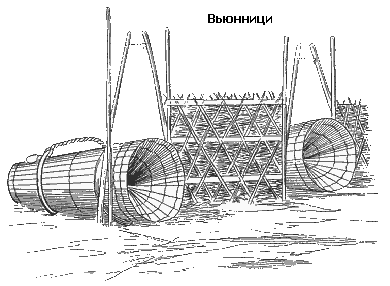
Lampreys are caught in even larger numbers, although more randomly and without real lamprey gear, on the lower Volga and Kura, but here at least 3/4 of the catch is used for fish oil. Lamprey fishing begins 50 versts below Saratov (higher up it is rarely found, since almost all of it is caught). Below Astrakhan, lampreys appear in October, and their progress continues until December. Fishing is carried out, as elsewhere, with frequent nerets (muzzles) woven from the willow. Catchers are paid 1 ruble. 50 k. per pood. The number of lampreys caught in the lower Volga is very significant, and should be counted in tens of thousands of pounds. For a pound of fat they pay from 2 to 4 rubles. The larvae of river lampreys, known on the Neva as live bait and blind bindweed, on the Dnieper as spindles and in Voronezh as peepers, serve in places where they are found in large numbers, as one of the best baits for catching predatory and even non-predatory fish on bottom fishing rods and lines, especially for chub, somenka, perch and burbot.
On the Neva, blind bindweeds are found in large numbers on the seashore in the silt, from where they are taken out by scooping them up with some kind of utensil and washing them. In the Northern basin Dvina, they are found in large numbers in creeks and lakes formed by the river, where they are caught directly by hand under the shore. In the r. In Voronezh, the main habitat of the squeak is near bridges, along muddy backwaters with humus, generally where, with an average flow or almost a backwater, the bottom is very loose, viscous and manure-laden. In such places the largest and fattest squeaker is found, but usually very sluggish and weak, which is why hunters prefer medium and almost small squeaks to it, which are mainly caught under koblas (blocks of black soil torn from the shore during floods), in fast shallow places and sandy soil. Voronezh fishermen catch squeakers by removing humus with a wide shovel or turning out the cobble from the bottom and disassembling the contents on the shore; but the most convenient way to get this attachment is with a strong bag. The latter is made here from the largest kitchen stag, on the ends of which, slightly apart, an iron strip like a scraper is attached, and the handle, bent at an angle, is attached to a long light pole. A rare, roomy bag with holes punched for water drainage is sewn to the stag itself and the scraper. With such “strokes” you can catch squeaks directly from the shore without getting into the water, which is extremely inconvenient in the fall. Piscava is one of the most durable live baits and, under favorable conditions, can live for 7-8 days. It is best to keep them in a wooden cage, lowered with a stone to the middle or almost to the bottom in fresh, running water. You can keep them for a day in a large row bag, pressing grass into it and lowering it (with a stone) near the shore under a bush, in the shade or under a boat. At night, if the air is colder than the water, it is a good idea to place the bag on the surface, untying its edge, slightly raised above the level, so that the contents do not escape. With free access to fresh air, the amount of necessary oxygen increases and those who have already begun to fall asleep acquire both strength and remarkable agility. It has been noticed that peepers, which turn reddish in the cage, live much longer; those that turn white are short-lived and must either be used immediately or thrown away. A dormant peeper decomposes extremely quickly and kills healthy ones. It is very easy to transport squeaks over a short distance in zinc (to avoid rust) containers filled with fresh, moistened grass or, even better, with a piece of ice placed on top.
Author: L.P.Sabaneev
FISH CATALOG
